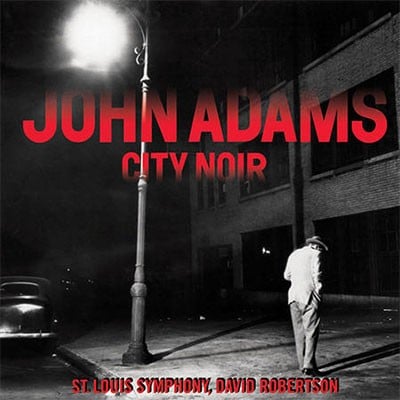picc.3(III=picc).3.corA.3(III=bcl).bcl.asax.dbn--6.4.3.1--timp.perc(5):vib/lg sus.cym/SD/bongos; tuned gongs/sus.cym/glsp/mar/tam-t/BD/chimes/vib/low tom-toms/tgl/castanets/cowbell/clave/temple bl; chimes/glsp/tamb/med tam-t/2 timbales/sus.cym/crotales/xyl; BD/tuned gongs/med tam-t/2 sus.cym/mar/crotales/castanet/tgl/glsp; 2 tam-t/BD/sus.cym/tgl/temple block/SD/2 tom-t/timbale/bongo/conga/tuned gongs.trap set--pft--cel--2harps--strings
Abbreviations (PDF)
Boosey & Hawkes (Hendon Music)
City Noir was first suggested by my reading the so-called “Dream” books by Kevin Starr, a brilliantly imagined, multi-volume cultural and social history of California. In the “Black Dahlia” chapter of his Embattled Dreams volume, Starr chronicles the tenor and milieu of the late ’40s and early ’50s as it was expressed in the sensational journalism of the era and in the dark, eerie chiaroscuro of the Hollywood films that have come to define the period sensibility for us:
“...the underside of home-front and post-war Los Angeles stood revealed. Still, for all its shoddiness, the City of Angels possessed a certain sassy, savvy energy. It was, among other things, a Front Page kind of town where life was lived by many on the edge, and that made for good copy and good film noir.”
Those images and their surrounding aura whetted my appetite for an orchestral work that, while not necessarily referring to the soundtracks of those films, might nevertheless evoke a similar mood and feeling tone of the era. I was also stimulated by the notion that there indeed exists a bona fide genre of jazz-inflected symphonic music, a fundamentally American orchestral style and tradition that goes back as far as the early 1920’s (although, truth to tell, it was a Frenchman, Darius Milhaud, who was the first to realize its potential with his 1923 ballet?La création du monde, a year before Gershwin’s?Rhapsody in Blue?premiered in New York).
The music of?City Noir?is in the form of a thirty-minute symphony. The formal and expressive weight of its three movements is distributed in pockets of high energy that are nested among areas of a more leisurely—one could even say “cinematic”—lyricism. The first movement, “The City and its Double,” opens with brief, powerful “wide screen” panorama that gives way to a murmuring dialogue between the double bass pizzicato and the scurrying figures in the woodwinds and keyboards. The steady tick of a jazz drummer impels this tense and nervous activity forward—a late-hour empty street scene, if you like. After a broad and lyrical melodic passage in the strings, the original scorrevole?movement returns, charged with increasingly insistent impulse and building up steam until it peaks with a full-throttle orchestral tutti. A surging melody in the horns and celli punctuated by jabbing brass “bullets” brings the movement to a nearly chaotic climax before it suddenly collapses into shards and fragments, a sudden stasis that ushers in the second movement.
The title, “The City and its Double” is a backward glance to the French playwright Antonin Artaud, who in his writings is said to have “opposed the vitality of the viewer’s sensual experience against [a conventional concept of] theater as a contrived literary form.” Hence my “city” can be imagined not just as geographic place or even as a social nexus, but rather as a source of inexhaustible sensual experience. As a child watching the early days of television I remember well the program that always ended with the familiar tag line, “There are eight million stories in the Naked City. This has been one.”
As a relief to the frenzy of the first movement’s ending, “The Song is for You,” takes its time assembling itself. Gradually a melodic profile in the solo alto sax emerges from the surrounding pools of chromatically tinted sonorities. The melody yearns toward but keeps retreating from the archetypal “blue” note. But eventually the song finds full bloom in the voice of the solo trombone, a “talking” solo, in the manner of the great Ellington soloists Lawence Brown and Britt Woodman (both, fittingly enough, Angelenos). The trombone music picks up motion and launches a brief passage of violent, centripetal energy, all focused on a short obsessive idea first stated by the sax. Once spent of its fuel, the movement returns to the quiet opening music, ending with pensive solos by the principal horn and viola.
“Boulevard Night” is a study in cinematic colors, sometimes, as in the moody “Chinatown” trumpet solo near the beginning, it is languorous and nocturnal; sometimes, as in the jerky stop-start coughing engine music in the staccato strings, it is animal and pulsing; and othertimes, as in the slinky, sinuous saxophone theme that keeps coming back, each time with an extra layer of stage makeup, it is in-your-face brash and uncouth. The music should have the slightly disorienting effect of a very crowded boulevard peopled with strange characters, like those of a David Lynch film—the kind who only come out very late on a very hot night.
—John Adams © 2009
“Making a telling artistic statement, Mr. Dudamel began his tenure conducting the premiere of the new Adams piece, City Noir, a bustling, complex work… He has become a master at piling up materials in thick yet lucid layers. Moment to moment the music is riveting.” NYTimes
“The first movement, titled The City and Its Double, is a swirling panoply of scurrying strings and winds, ominous brass chords, syncopated jazz drumming, along with, typically in Adams, syncopated everything. Melodies appear as inexplicably as a dirty blond in Philip Marlowe’s office. The second movement is softer and, on the surface, sweeter than the first, and jazzy … The third movement, Boulevard Night, begins with a CinemaScope sunrise, which is followed by a dazzling trumpet solo. Stravinsky pops up here as well in a knockout finale.” LATimes
“…a gritty, sultry, and wonderfully inventive 35-minute symphony…” Boston Globe

Saint Louis Symphony Orchestra/David Robertson
Nonesuch 7559795644

